POLS 8296: Essay on Australian Prime Ministerial Changes Since 2010
VerifiedAdded on 2023/06/13
|9
|2494
|221
Essay
AI Summary
This essay provides an introduction to politics and government in Australia, focusing on the changes in the Prime Minister position since 2010. It examines the reasons for the individual changes of Prime Ministers, including the tenures of Kevin Rudd, Julia Gillard, Tony Abbott, and Malcolm Turnbull, highlighting the political factors and decisions that led to their ousting or resignation. The essay also discusses the effects of these changes on the stability and operation of the Australian government, arguing that the changes cause little disruption due to the distribution of power and the shared political ideologies of the major parties. The role of the Prime Minister as a figurehead and the strength of the parliamentary system are emphasized as factors contributing to the resilience of the Australian political system despite frequent leadership changes. The document is available on Desklib, a platform offering study tools and resources for students.
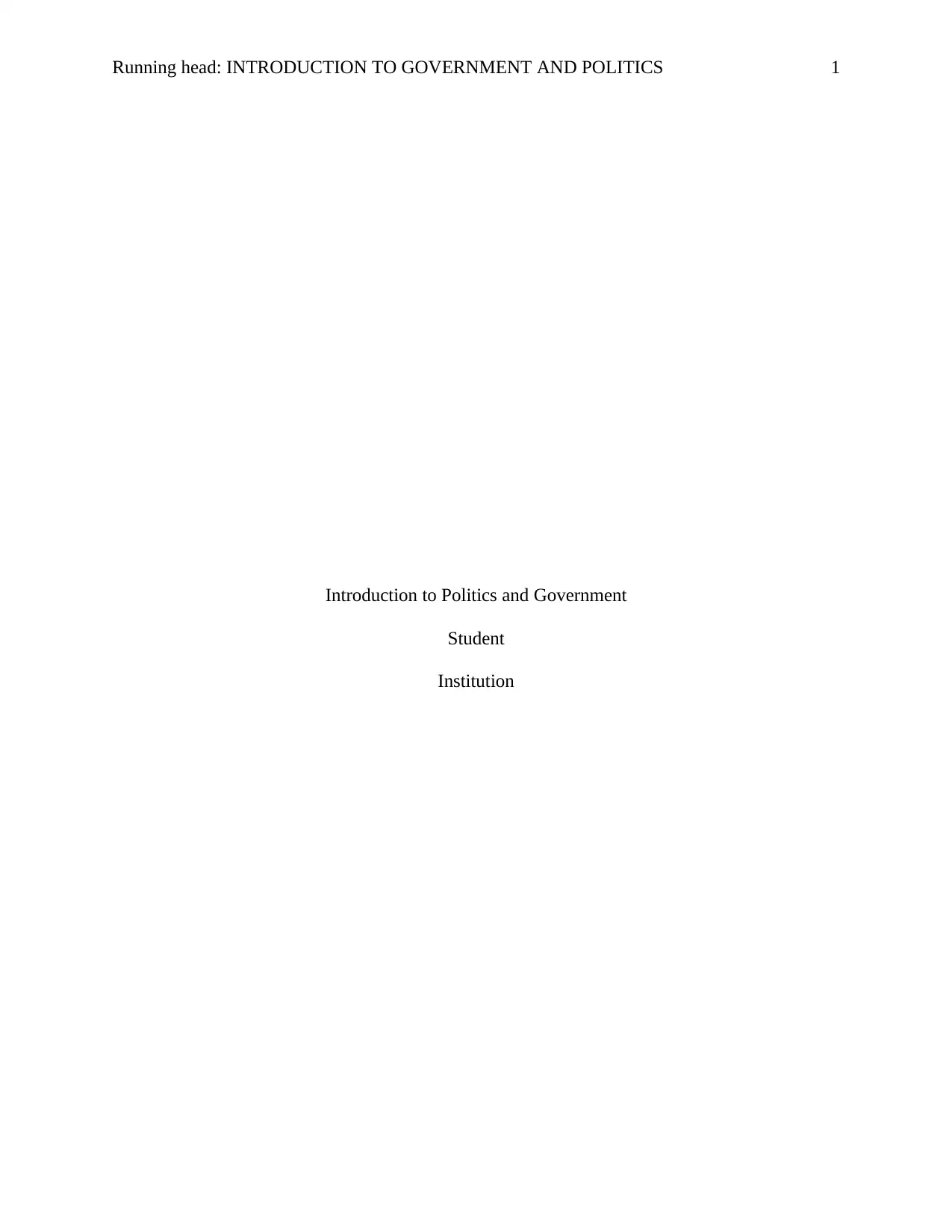
Running head: INTRODUCTION TO GOVERNMENT AND POLITICS 1
Introduction to Politics and Government
Student
Institution
Introduction to Politics and Government
Student
Institution
Paraphrase This Document
Need a fresh take? Get an instant paraphrase of this document with our AI Paraphraser
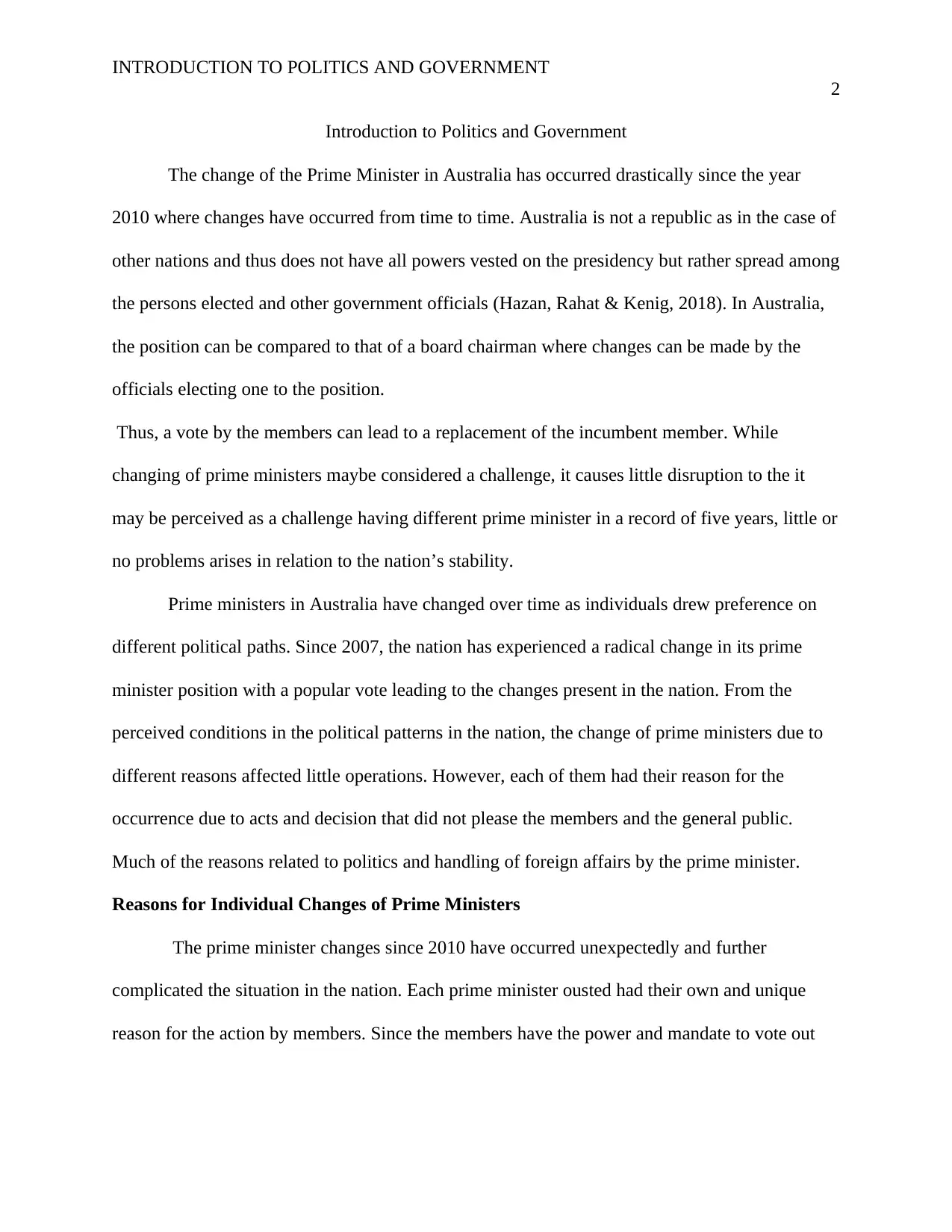
INTRODUCTION TO POLITICS AND GOVERNMENT
2
Introduction to Politics and Government
The change of the Prime Minister in Australia has occurred drastically since the year
2010 where changes have occurred from time to time. Australia is not a republic as in the case of
other nations and thus does not have all powers vested on the presidency but rather spread among
the persons elected and other government officials (Hazan, Rahat & Kenig, 2018). In Australia,
the position can be compared to that of a board chairman where changes can be made by the
officials electing one to the position.
Thus, a vote by the members can lead to a replacement of the incumbent member. While
changing of prime ministers maybe considered a challenge, it causes little disruption to the it
may be perceived as a challenge having different prime minister in a record of five years, little or
no problems arises in relation to the nation’s stability.
Prime ministers in Australia have changed over time as individuals drew preference on
different political paths. Since 2007, the nation has experienced a radical change in its prime
minister position with a popular vote leading to the changes present in the nation. From the
perceived conditions in the political patterns in the nation, the change of prime ministers due to
different reasons affected little operations. However, each of them had their reason for the
occurrence due to acts and decision that did not please the members and the general public.
Much of the reasons related to politics and handling of foreign affairs by the prime minister.
Reasons for Individual Changes of Prime Ministers
The prime minister changes since 2010 have occurred unexpectedly and further
complicated the situation in the nation. Each prime minister ousted had their own and unique
reason for the action by members. Since the members have the power and mandate to vote out
2
Introduction to Politics and Government
The change of the Prime Minister in Australia has occurred drastically since the year
2010 where changes have occurred from time to time. Australia is not a republic as in the case of
other nations and thus does not have all powers vested on the presidency but rather spread among
the persons elected and other government officials (Hazan, Rahat & Kenig, 2018). In Australia,
the position can be compared to that of a board chairman where changes can be made by the
officials electing one to the position.
Thus, a vote by the members can lead to a replacement of the incumbent member. While
changing of prime ministers maybe considered a challenge, it causes little disruption to the it
may be perceived as a challenge having different prime minister in a record of five years, little or
no problems arises in relation to the nation’s stability.
Prime ministers in Australia have changed over time as individuals drew preference on
different political paths. Since 2007, the nation has experienced a radical change in its prime
minister position with a popular vote leading to the changes present in the nation. From the
perceived conditions in the political patterns in the nation, the change of prime ministers due to
different reasons affected little operations. However, each of them had their reason for the
occurrence due to acts and decision that did not please the members and the general public.
Much of the reasons related to politics and handling of foreign affairs by the prime minister.
Reasons for Individual Changes of Prime Ministers
The prime minister changes since 2010 have occurred unexpectedly and further
complicated the situation in the nation. Each prime minister ousted had their own and unique
reason for the action by members. Since the members have the power and mandate to vote out
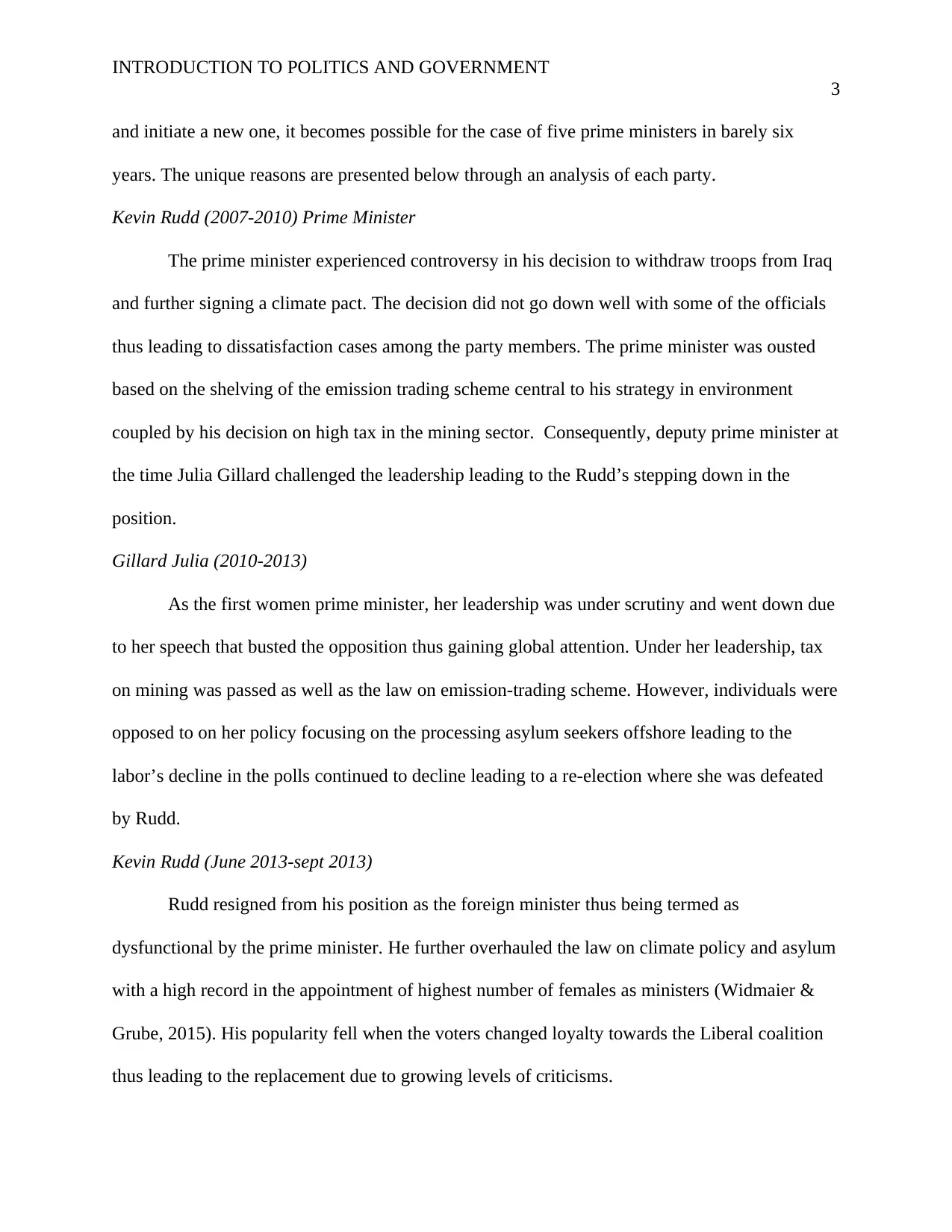
INTRODUCTION TO POLITICS AND GOVERNMENT
3
and initiate a new one, it becomes possible for the case of five prime ministers in barely six
years. The unique reasons are presented below through an analysis of each party.
Kevin Rudd (2007-2010) Prime Minister
The prime minister experienced controversy in his decision to withdraw troops from Iraq
and further signing a climate pact. The decision did not go down well with some of the officials
thus leading to dissatisfaction cases among the party members. The prime minister was ousted
based on the shelving of the emission trading scheme central to his strategy in environment
coupled by his decision on high tax in the mining sector. Consequently, deputy prime minister at
the time Julia Gillard challenged the leadership leading to the Rudd’s stepping down in the
position.
Gillard Julia (2010-2013)
As the first women prime minister, her leadership was under scrutiny and went down due
to her speech that busted the opposition thus gaining global attention. Under her leadership, tax
on mining was passed as well as the law on emission-trading scheme. However, individuals were
opposed to on her policy focusing on the processing asylum seekers offshore leading to the
labor’s decline in the polls continued to decline leading to a re-election where she was defeated
by Rudd.
Kevin Rudd (June 2013-sept 2013)
Rudd resigned from his position as the foreign minister thus being termed as
dysfunctional by the prime minister. He further overhauled the law on climate policy and asylum
with a high record in the appointment of highest number of females as ministers (Widmaier &
Grube, 2015). His popularity fell when the voters changed loyalty towards the Liberal coalition
thus leading to the replacement due to growing levels of criticisms.
3
and initiate a new one, it becomes possible for the case of five prime ministers in barely six
years. The unique reasons are presented below through an analysis of each party.
Kevin Rudd (2007-2010) Prime Minister
The prime minister experienced controversy in his decision to withdraw troops from Iraq
and further signing a climate pact. The decision did not go down well with some of the officials
thus leading to dissatisfaction cases among the party members. The prime minister was ousted
based on the shelving of the emission trading scheme central to his strategy in environment
coupled by his decision on high tax in the mining sector. Consequently, deputy prime minister at
the time Julia Gillard challenged the leadership leading to the Rudd’s stepping down in the
position.
Gillard Julia (2010-2013)
As the first women prime minister, her leadership was under scrutiny and went down due
to her speech that busted the opposition thus gaining global attention. Under her leadership, tax
on mining was passed as well as the law on emission-trading scheme. However, individuals were
opposed to on her policy focusing on the processing asylum seekers offshore leading to the
labor’s decline in the polls continued to decline leading to a re-election where she was defeated
by Rudd.
Kevin Rudd (June 2013-sept 2013)
Rudd resigned from his position as the foreign minister thus being termed as
dysfunctional by the prime minister. He further overhauled the law on climate policy and asylum
with a high record in the appointment of highest number of females as ministers (Widmaier &
Grube, 2015). His popularity fell when the voters changed loyalty towards the Liberal coalition
thus leading to the replacement due to growing levels of criticisms.
⊘ This is a preview!⊘
Do you want full access?
Subscribe today to unlock all pages.

Trusted by 1+ million students worldwide
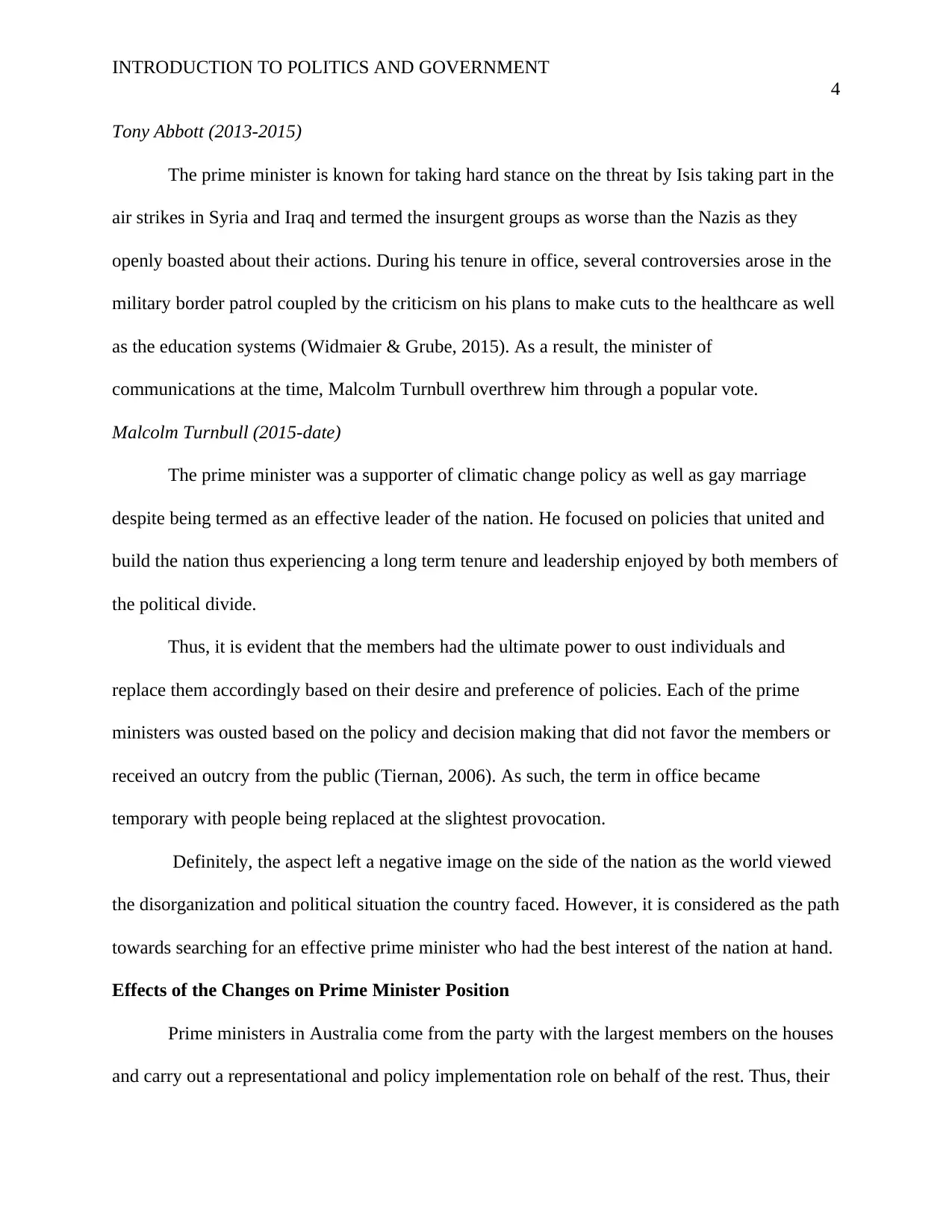
INTRODUCTION TO POLITICS AND GOVERNMENT
4
Tony Abbott (2013-2015)
The prime minister is known for taking hard stance on the threat by Isis taking part in the
air strikes in Syria and Iraq and termed the insurgent groups as worse than the Nazis as they
openly boasted about their actions. During his tenure in office, several controversies arose in the
military border patrol coupled by the criticism on his plans to make cuts to the healthcare as well
as the education systems (Widmaier & Grube, 2015). As a result, the minister of
communications at the time, Malcolm Turnbull overthrew him through a popular vote.
Malcolm Turnbull (2015-date)
The prime minister was a supporter of climatic change policy as well as gay marriage
despite being termed as an effective leader of the nation. He focused on policies that united and
build the nation thus experiencing a long term tenure and leadership enjoyed by both members of
the political divide.
Thus, it is evident that the members had the ultimate power to oust individuals and
replace them accordingly based on their desire and preference of policies. Each of the prime
ministers was ousted based on the policy and decision making that did not favor the members or
received an outcry from the public (Tiernan, 2006). As such, the term in office became
temporary with people being replaced at the slightest provocation.
Definitely, the aspect left a negative image on the side of the nation as the world viewed
the disorganization and political situation the country faced. However, it is considered as the path
towards searching for an effective prime minister who had the best interest of the nation at hand.
Effects of the Changes on Prime Minister Position
Prime ministers in Australia come from the party with the largest members on the houses
and carry out a representational and policy implementation role on behalf of the rest. Thus, their
4
Tony Abbott (2013-2015)
The prime minister is known for taking hard stance on the threat by Isis taking part in the
air strikes in Syria and Iraq and termed the insurgent groups as worse than the Nazis as they
openly boasted about their actions. During his tenure in office, several controversies arose in the
military border patrol coupled by the criticism on his plans to make cuts to the healthcare as well
as the education systems (Widmaier & Grube, 2015). As a result, the minister of
communications at the time, Malcolm Turnbull overthrew him through a popular vote.
Malcolm Turnbull (2015-date)
The prime minister was a supporter of climatic change policy as well as gay marriage
despite being termed as an effective leader of the nation. He focused on policies that united and
build the nation thus experiencing a long term tenure and leadership enjoyed by both members of
the political divide.
Thus, it is evident that the members had the ultimate power to oust individuals and
replace them accordingly based on their desire and preference of policies. Each of the prime
ministers was ousted based on the policy and decision making that did not favor the members or
received an outcry from the public (Tiernan, 2006). As such, the term in office became
temporary with people being replaced at the slightest provocation.
Definitely, the aspect left a negative image on the side of the nation as the world viewed
the disorganization and political situation the country faced. However, it is considered as the path
towards searching for an effective prime minister who had the best interest of the nation at hand.
Effects of the Changes on Prime Minister Position
Prime ministers in Australia come from the party with the largest members on the houses
and carry out a representational and policy implementation role on behalf of the rest. Thus, their
Paraphrase This Document
Need a fresh take? Get an instant paraphrase of this document with our AI Paraphraser
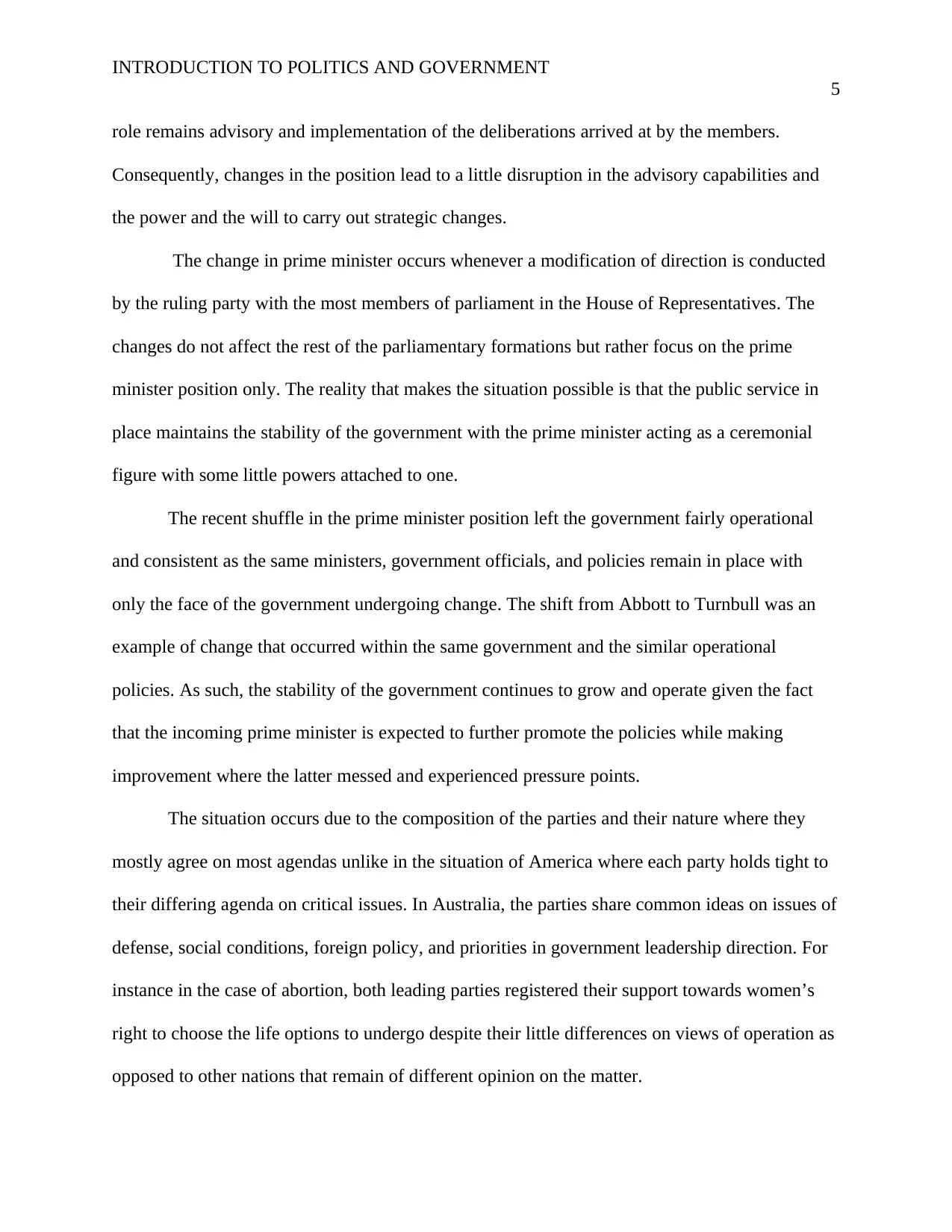
INTRODUCTION TO POLITICS AND GOVERNMENT
5
role remains advisory and implementation of the deliberations arrived at by the members.
Consequently, changes in the position lead to a little disruption in the advisory capabilities and
the power and the will to carry out strategic changes.
The change in prime minister occurs whenever a modification of direction is conducted
by the ruling party with the most members of parliament in the House of Representatives. The
changes do not affect the rest of the parliamentary formations but rather focus on the prime
minister position only. The reality that makes the situation possible is that the public service in
place maintains the stability of the government with the prime minister acting as a ceremonial
figure with some little powers attached to one.
The recent shuffle in the prime minister position left the government fairly operational
and consistent as the same ministers, government officials, and policies remain in place with
only the face of the government undergoing change. The shift from Abbott to Turnbull was an
example of change that occurred within the same government and the similar operational
policies. As such, the stability of the government continues to grow and operate given the fact
that the incoming prime minister is expected to further promote the policies while making
improvement where the latter messed and experienced pressure points.
The situation occurs due to the composition of the parties and their nature where they
mostly agree on most agendas unlike in the situation of America where each party holds tight to
their differing agenda on critical issues. In Australia, the parties share common ideas on issues of
defense, social conditions, foreign policy, and priorities in government leadership direction. For
instance in the case of abortion, both leading parties registered their support towards women’s
right to choose the life options to undergo despite their little differences on views of operation as
opposed to other nations that remain of different opinion on the matter.
5
role remains advisory and implementation of the deliberations arrived at by the members.
Consequently, changes in the position lead to a little disruption in the advisory capabilities and
the power and the will to carry out strategic changes.
The change in prime minister occurs whenever a modification of direction is conducted
by the ruling party with the most members of parliament in the House of Representatives. The
changes do not affect the rest of the parliamentary formations but rather focus on the prime
minister position only. The reality that makes the situation possible is that the public service in
place maintains the stability of the government with the prime minister acting as a ceremonial
figure with some little powers attached to one.
The recent shuffle in the prime minister position left the government fairly operational
and consistent as the same ministers, government officials, and policies remain in place with
only the face of the government undergoing change. The shift from Abbott to Turnbull was an
example of change that occurred within the same government and the similar operational
policies. As such, the stability of the government continues to grow and operate given the fact
that the incoming prime minister is expected to further promote the policies while making
improvement where the latter messed and experienced pressure points.
The situation occurs due to the composition of the parties and their nature where they
mostly agree on most agendas unlike in the situation of America where each party holds tight to
their differing agenda on critical issues. In Australia, the parties share common ideas on issues of
defense, social conditions, foreign policy, and priorities in government leadership direction. For
instance in the case of abortion, both leading parties registered their support towards women’s
right to choose the life options to undergo despite their little differences on views of operation as
opposed to other nations that remain of different opinion on the matter.
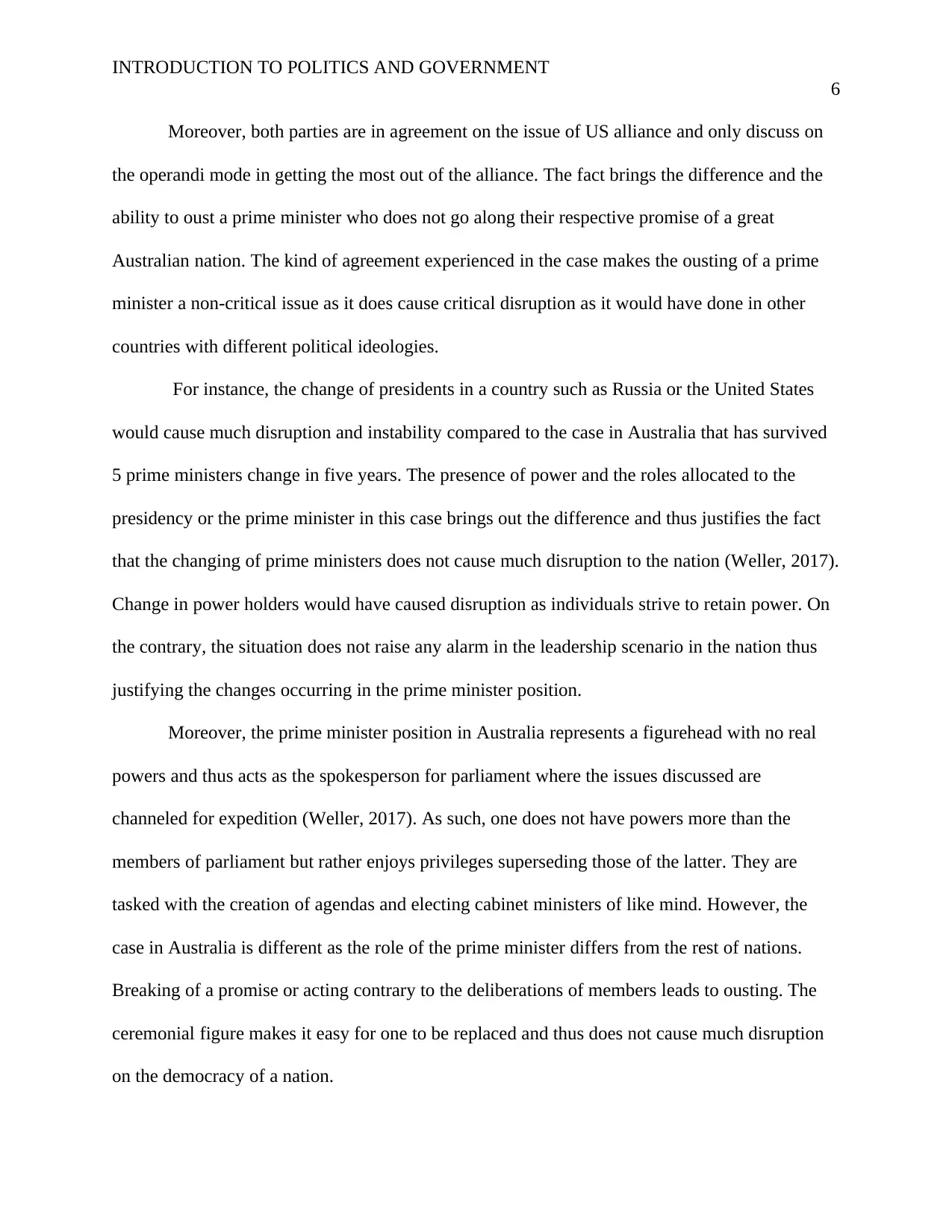
INTRODUCTION TO POLITICS AND GOVERNMENT
6
Moreover, both parties are in agreement on the issue of US alliance and only discuss on
the operandi mode in getting the most out of the alliance. The fact brings the difference and the
ability to oust a prime minister who does not go along their respective promise of a great
Australian nation. The kind of agreement experienced in the case makes the ousting of a prime
minister a non-critical issue as it does cause critical disruption as it would have done in other
countries with different political ideologies.
For instance, the change of presidents in a country such as Russia or the United States
would cause much disruption and instability compared to the case in Australia that has survived
5 prime ministers change in five years. The presence of power and the roles allocated to the
presidency or the prime minister in this case brings out the difference and thus justifies the fact
that the changing of prime ministers does not cause much disruption to the nation (Weller, 2017).
Change in power holders would have caused disruption as individuals strive to retain power. On
the contrary, the situation does not raise any alarm in the leadership scenario in the nation thus
justifying the changes occurring in the prime minister position.
Moreover, the prime minister position in Australia represents a figurehead with no real
powers and thus acts as the spokesperson for parliament where the issues discussed are
channeled for expedition (Weller, 2017). As such, one does not have powers more than the
members of parliament but rather enjoys privileges superseding those of the latter. They are
tasked with the creation of agendas and electing cabinet ministers of like mind. However, the
case in Australia is different as the role of the prime minister differs from the rest of nations.
Breaking of a promise or acting contrary to the deliberations of members leads to ousting. The
ceremonial figure makes it easy for one to be replaced and thus does not cause much disruption
on the democracy of a nation.
6
Moreover, both parties are in agreement on the issue of US alliance and only discuss on
the operandi mode in getting the most out of the alliance. The fact brings the difference and the
ability to oust a prime minister who does not go along their respective promise of a great
Australian nation. The kind of agreement experienced in the case makes the ousting of a prime
minister a non-critical issue as it does cause critical disruption as it would have done in other
countries with different political ideologies.
For instance, the change of presidents in a country such as Russia or the United States
would cause much disruption and instability compared to the case in Australia that has survived
5 prime ministers change in five years. The presence of power and the roles allocated to the
presidency or the prime minister in this case brings out the difference and thus justifies the fact
that the changing of prime ministers does not cause much disruption to the nation (Weller, 2017).
Change in power holders would have caused disruption as individuals strive to retain power. On
the contrary, the situation does not raise any alarm in the leadership scenario in the nation thus
justifying the changes occurring in the prime minister position.
Moreover, the prime minister position in Australia represents a figurehead with no real
powers and thus acts as the spokesperson for parliament where the issues discussed are
channeled for expedition (Weller, 2017). As such, one does not have powers more than the
members of parliament but rather enjoys privileges superseding those of the latter. They are
tasked with the creation of agendas and electing cabinet ministers of like mind. However, the
case in Australia is different as the role of the prime minister differs from the rest of nations.
Breaking of a promise or acting contrary to the deliberations of members leads to ousting. The
ceremonial figure makes it easy for one to be replaced and thus does not cause much disruption
on the democracy of a nation.
⊘ This is a preview!⊘
Do you want full access?
Subscribe today to unlock all pages.

Trusted by 1+ million students worldwide
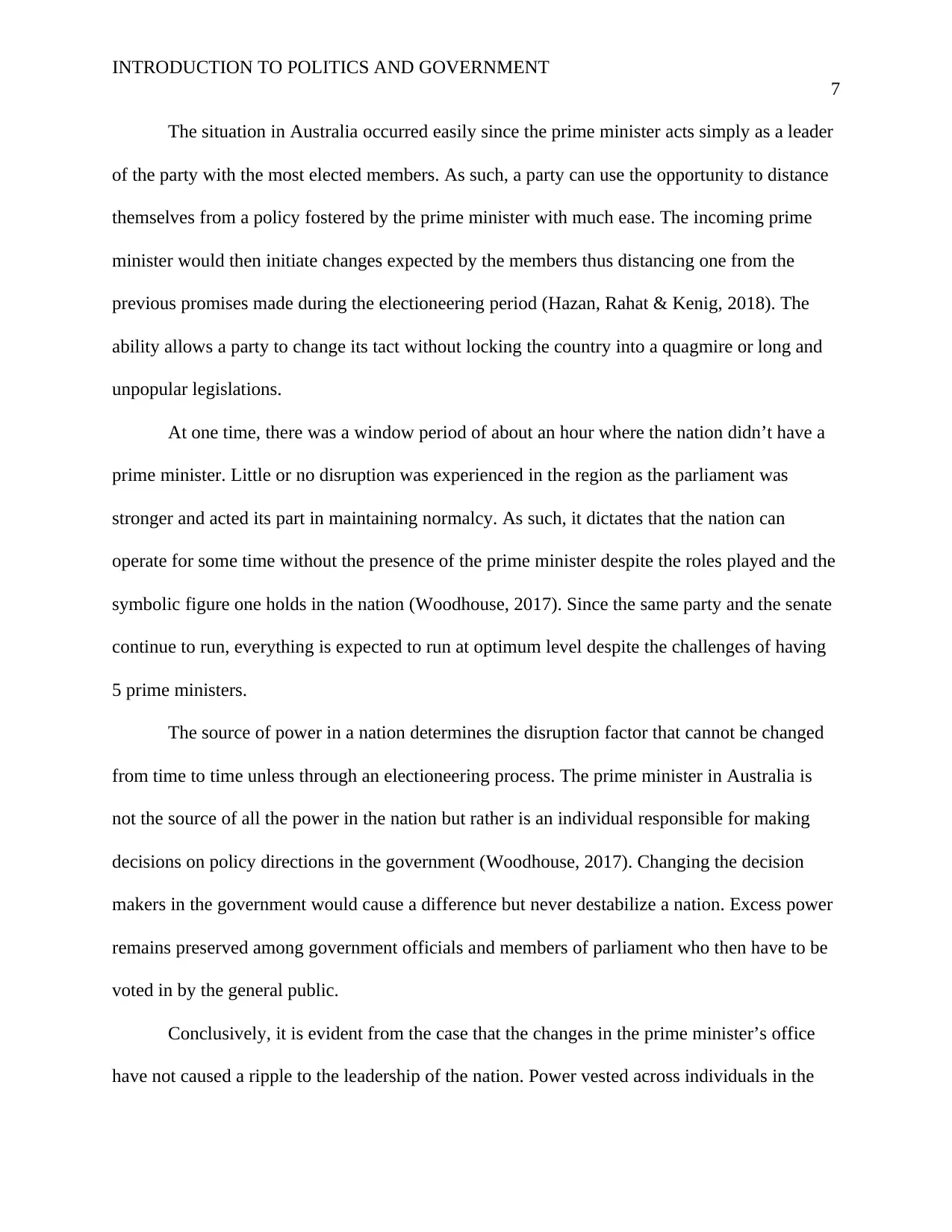
INTRODUCTION TO POLITICS AND GOVERNMENT
7
The situation in Australia occurred easily since the prime minister acts simply as a leader
of the party with the most elected members. As such, a party can use the opportunity to distance
themselves from a policy fostered by the prime minister with much ease. The incoming prime
minister would then initiate changes expected by the members thus distancing one from the
previous promises made during the electioneering period (Hazan, Rahat & Kenig, 2018). The
ability allows a party to change its tact without locking the country into a quagmire or long and
unpopular legislations.
At one time, there was a window period of about an hour where the nation didn’t have a
prime minister. Little or no disruption was experienced in the region as the parliament was
stronger and acted its part in maintaining normalcy. As such, it dictates that the nation can
operate for some time without the presence of the prime minister despite the roles played and the
symbolic figure one holds in the nation (Woodhouse, 2017). Since the same party and the senate
continue to run, everything is expected to run at optimum level despite the challenges of having
5 prime ministers.
The source of power in a nation determines the disruption factor that cannot be changed
from time to time unless through an electioneering process. The prime minister in Australia is
not the source of all the power in the nation but rather is an individual responsible for making
decisions on policy directions in the government (Woodhouse, 2017). Changing the decision
makers in the government would cause a difference but never destabilize a nation. Excess power
remains preserved among government officials and members of parliament who then have to be
voted in by the general public.
Conclusively, it is evident from the case that the changes in the prime minister’s office
have not caused a ripple to the leadership of the nation. Power vested across individuals in the
7
The situation in Australia occurred easily since the prime minister acts simply as a leader
of the party with the most elected members. As such, a party can use the opportunity to distance
themselves from a policy fostered by the prime minister with much ease. The incoming prime
minister would then initiate changes expected by the members thus distancing one from the
previous promises made during the electioneering period (Hazan, Rahat & Kenig, 2018). The
ability allows a party to change its tact without locking the country into a quagmire or long and
unpopular legislations.
At one time, there was a window period of about an hour where the nation didn’t have a
prime minister. Little or no disruption was experienced in the region as the parliament was
stronger and acted its part in maintaining normalcy. As such, it dictates that the nation can
operate for some time without the presence of the prime minister despite the roles played and the
symbolic figure one holds in the nation (Woodhouse, 2017). Since the same party and the senate
continue to run, everything is expected to run at optimum level despite the challenges of having
5 prime ministers.
The source of power in a nation determines the disruption factor that cannot be changed
from time to time unless through an electioneering process. The prime minister in Australia is
not the source of all the power in the nation but rather is an individual responsible for making
decisions on policy directions in the government (Woodhouse, 2017). Changing the decision
makers in the government would cause a difference but never destabilize a nation. Excess power
remains preserved among government officials and members of parliament who then have to be
voted in by the general public.
Conclusively, it is evident from the case that the changes in the prime minister’s office
have not caused a ripple to the leadership of the nation. Power vested across individuals in the
Paraphrase This Document
Need a fresh take? Get an instant paraphrase of this document with our AI Paraphraser
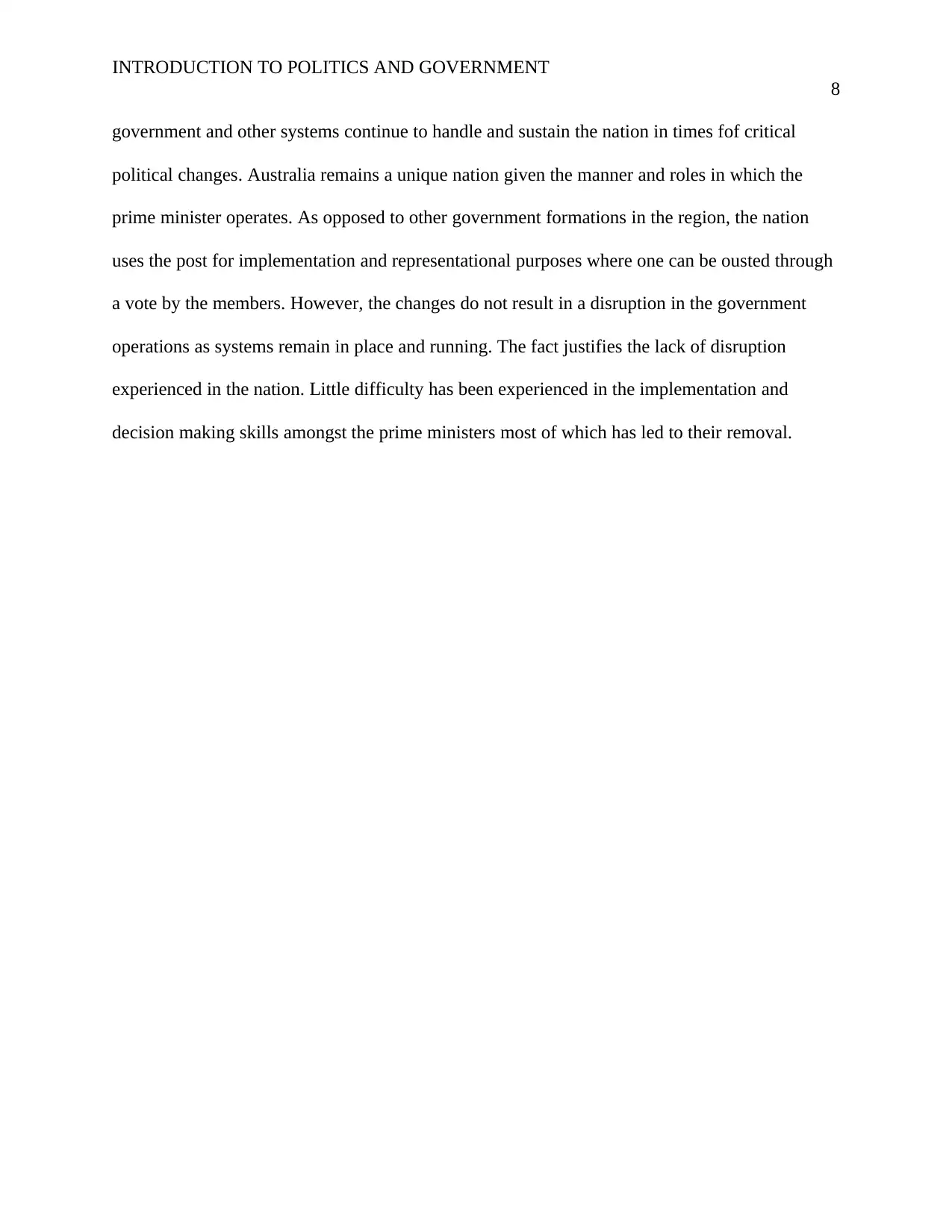
INTRODUCTION TO POLITICS AND GOVERNMENT
8
government and other systems continue to handle and sustain the nation in times fof critical
political changes. Australia remains a unique nation given the manner and roles in which the
prime minister operates. As opposed to other government formations in the region, the nation
uses the post for implementation and representational purposes where one can be ousted through
a vote by the members. However, the changes do not result in a disruption in the government
operations as systems remain in place and running. The fact justifies the lack of disruption
experienced in the nation. Little difficulty has been experienced in the implementation and
decision making skills amongst the prime ministers most of which has led to their removal.
8
government and other systems continue to handle and sustain the nation in times fof critical
political changes. Australia remains a unique nation given the manner and roles in which the
prime minister operates. As opposed to other government formations in the region, the nation
uses the post for implementation and representational purposes where one can be ousted through
a vote by the members. However, the changes do not result in a disruption in the government
operations as systems remain in place and running. The fact justifies the lack of disruption
experienced in the nation. Little difficulty has been experienced in the implementation and
decision making skills amongst the prime ministers most of which has led to their removal.
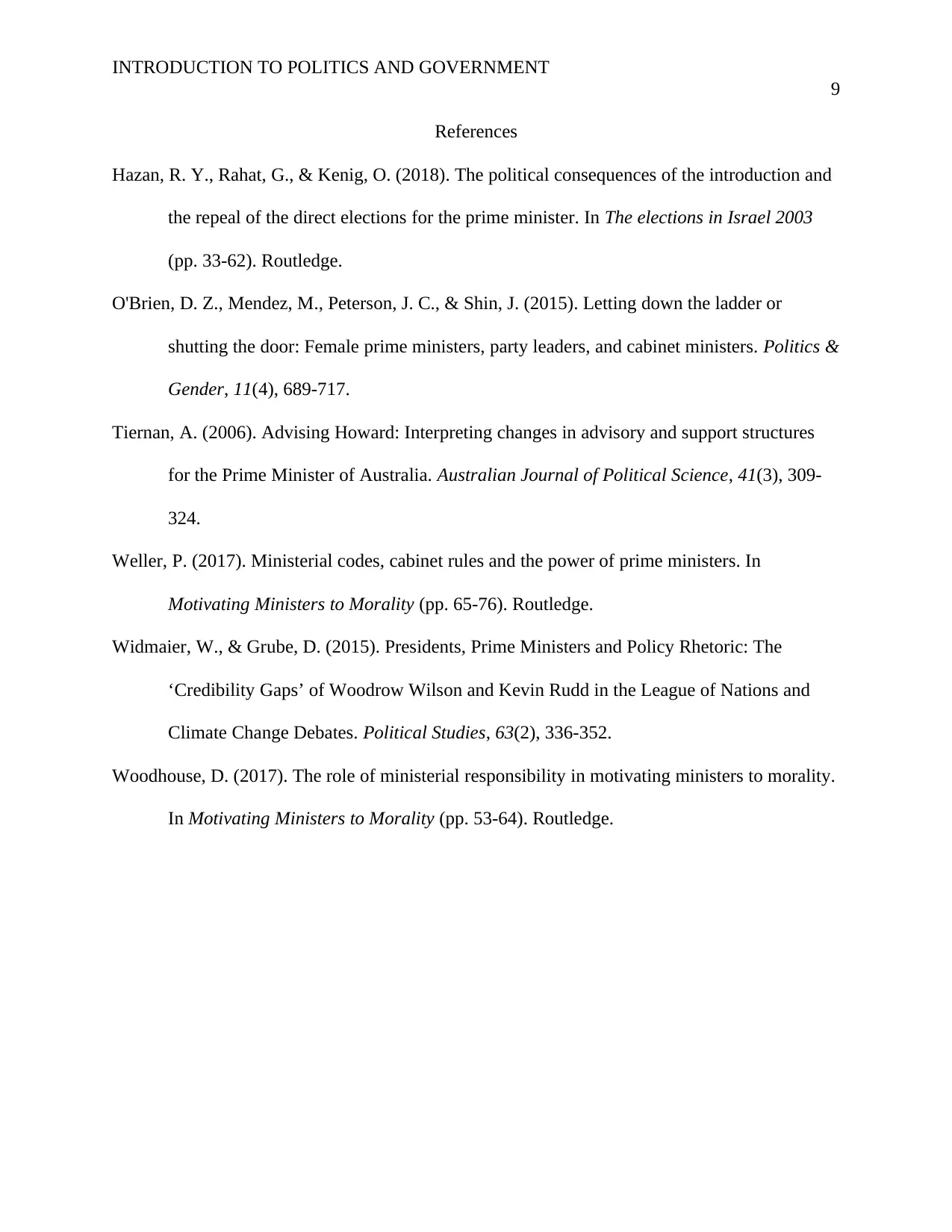
INTRODUCTION TO POLITICS AND GOVERNMENT
9
References
Hazan, R. Y., Rahat, G., & Kenig, O. (2018). The political consequences of the introduction and
the repeal of the direct elections for the prime minister. In The elections in Israel 2003
(pp. 33-62). Routledge.
O'Brien, D. Z., Mendez, M., Peterson, J. C., & Shin, J. (2015). Letting down the ladder or
shutting the door: Female prime ministers, party leaders, and cabinet ministers. Politics &
Gender, 11(4), 689-717.
Tiernan, A. (2006). Advising Howard: Interpreting changes in advisory and support structures
for the Prime Minister of Australia. Australian Journal of Political Science, 41(3), 309-
324.
Weller, P. (2017). Ministerial codes, cabinet rules and the power of prime ministers. In
Motivating Ministers to Morality (pp. 65-76). Routledge.
Widmaier, W., & Grube, D. (2015). Presidents, Prime Ministers and Policy Rhetoric: The
‘Credibility Gaps’ of Woodrow Wilson and Kevin Rudd in the League of Nations and
Climate Change Debates. Political Studies, 63(2), 336-352.
Woodhouse, D. (2017). The role of ministerial responsibility in motivating ministers to morality.
In Motivating Ministers to Morality (pp. 53-64). Routledge.
9
References
Hazan, R. Y., Rahat, G., & Kenig, O. (2018). The political consequences of the introduction and
the repeal of the direct elections for the prime minister. In The elections in Israel 2003
(pp. 33-62). Routledge.
O'Brien, D. Z., Mendez, M., Peterson, J. C., & Shin, J. (2015). Letting down the ladder or
shutting the door: Female prime ministers, party leaders, and cabinet ministers. Politics &
Gender, 11(4), 689-717.
Tiernan, A. (2006). Advising Howard: Interpreting changes in advisory and support structures
for the Prime Minister of Australia. Australian Journal of Political Science, 41(3), 309-
324.
Weller, P. (2017). Ministerial codes, cabinet rules and the power of prime ministers. In
Motivating Ministers to Morality (pp. 65-76). Routledge.
Widmaier, W., & Grube, D. (2015). Presidents, Prime Ministers and Policy Rhetoric: The
‘Credibility Gaps’ of Woodrow Wilson and Kevin Rudd in the League of Nations and
Climate Change Debates. Political Studies, 63(2), 336-352.
Woodhouse, D. (2017). The role of ministerial responsibility in motivating ministers to morality.
In Motivating Ministers to Morality (pp. 53-64). Routledge.
⊘ This is a preview!⊘
Do you want full access?
Subscribe today to unlock all pages.

Trusted by 1+ million students worldwide
1 out of 9
Related Documents
Your All-in-One AI-Powered Toolkit for Academic Success.
+13062052269
info@desklib.com
Available 24*7 on WhatsApp / Email
![[object Object]](/_next/static/media/star-bottom.7253800d.svg)
Unlock your academic potential
Copyright © 2020–2025 A2Z Services. All Rights Reserved. Developed and managed by ZUCOL.





